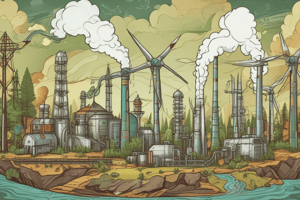Podcast
Questions and Answers
What is the primary motivation behind seeking alternative energy sources like biomass energy?
What is the primary motivation behind seeking alternative energy sources like biomass energy?
- To reduce the harmful impacts of climate change (correct)
- To create new industries and jobs
- To increase energy independence
- To reduce the cost of energy production
What is the primary advantage of using algae as a biomass energy source?
What is the primary advantage of using algae as a biomass energy source?
- It requires less space than other feedstocks (correct)
- It is a highly abundant resource
- It is a more efficient energy source
- It is cheaper to produce than other biofuels
What is the term for fuels made from biomass derivatives?
What is the term for fuels made from biomass derivatives?
- Alternative energy
- Biomass energy
- Biofuels (correct)
- Renewable energy
What is the simplest way to convert biomass feedstocks into energy?
What is the simplest way to convert biomass feedstocks into energy?
What is the term for organic materials like sugar cane, wood, and animal waste that are used to produce biomass energy?
What is the term for organic materials like sugar cane, wood, and animal waste that are used to produce biomass energy?
What is the purpose of fermentation in biomass energy production?
What is the purpose of fermentation in biomass energy production?
What is the primary advantage of co-firing biomass with fossil fuels?
What is the primary advantage of co-firing biomass with fossil fuels?
What is the significance of carbon neutrality in biomass energy?
What is the significance of carbon neutrality in biomass energy?
What is pyrolysis used to produce?
What is pyrolysis used to produce?
What is a limitation of biomass energy according to critics?
What is a limitation of biomass energy according to critics?
Why is algae processing not a feasible alternative in many areas?
Why is algae processing not a feasible alternative in many areas?
What is a challenge when dealing with imported feedstocks?
What is a challenge when dealing with imported feedstocks?
What is a concern with dedicating large tracts of land to energy crops?
What is a concern with dedicating large tracts of land to energy crops?
What is a problem with clearing forests faster than they can regrow?
What is a problem with clearing forests faster than they can regrow?
Why do young trees not guarantee a complete carbon offset?
Why do young trees not guarantee a complete carbon offset?
Flashcards are hidden until you start studying
Study Notes
Biomass Energy Overview
- Biomass energy is an alternative to fossil fuels, aiming to reduce greenhouse gas emissions and combat climate change.
- Biomass energy comes from organic materials like sugar cane, wood, animal waste, grasses, food crops, and algae.
Biomass Feedstocks
- Biomass feedstocks include energy crops grown specifically for use in fuels, such as soy and corn.
- Organic industrial waste, like sawdust and discarded lumber, can be burned directly or converted into other energy sources.
- Algae is a promising biomass energy source due to its rapid growth and energy production.
Converting Biomass to Energy
- Converting biomass to energy involves processes like gasification, co-firing, fermentation, and pyrolysis.
- Gasification combines biomass with oxygen, producing carbon monoxide and hydrogen (syngas).
- Co-firing involves burning biomass alongside fossil fuels to reduce pollution emissions.
- Fermentation uses microbes to decompose sugars into carbon dioxide and ethanol.
- Pyrolysis involves heating biomass to produce combustible gases and bio-oil.
Biomass Energy Pros and Cons
Pros
- Biomass energy is potentially carbon neutral, as new sources absorb and sequester carbon dioxide during regrowth.
- Biomass energy is abundant, with sources like algae, corn, and soybeans.
- Biomass energy sources quickly renew themselves through continuous growth.
Cons
- Initial costs of equipment for processes like gasification and pyrolysis can be high.
- Transportation and storage of energy crops, wood pellets, and forestry waste can be cumbersome and costly.
- Dedication of arable land to energy crops reduces acreage for food crops and livestock.
- Biomass energy harvesting requires careful management to remain renewable and carbon neutral.
Studying That Suits You
Use AI to generate personalized quizzes and flashcards to suit your learning preferences.





